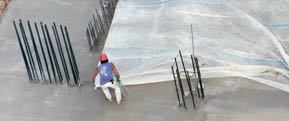Category
- Concrete Best Practices

What is curing?
Concrete curing is the process where sufficient moisture and temperature conditions are maintained in order to promote hydration – the chemical reaction between cement and water.
Why is it important to cure?
Properly curing concrete is an essential step in producing durable, high strength concrete. Adequate hydration through curing minimizes drying shrinkage cracks. Over time, curing pays for itself by increasing the concrete’s durability and lifespan and by reducing the need for repairing cracks and leaks.
What are some curing methods?
According to the American Concrete Institute’s Standard Practice for Curing Concrete (ACI 308), curing should be continuous for a minimum of seven days or until 70 per cent of the specified strength has been attained.
Proper curing techniques are commonly categorized into two groups:
1) Continually or frequently applying water (e.g. ponding or immersion, spraying or fogging, using saturated wet coverings, etc.)
2) Preventing excessive evaporation using sealing materials (e.g. covering with imperious paper or plastic sheets, using a membrane-forming curing compound, etc.)



